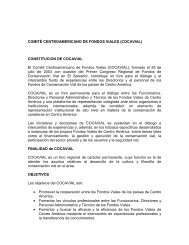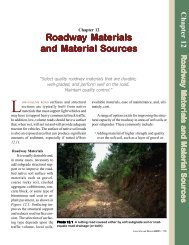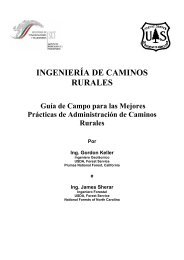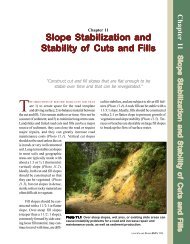Create successful ePaper yourself
Turn your PDF publications into a flip-book with our unique Google optimized e-Paper software.
slow down the velocity <strong>of</strong> water,<br />
as shown in Figure 7.8. Ditches<br />
are commonly armored with grass,<br />
erosion control matting, rock, or<br />
masonry /concrete paving (Photo<br />
7.6). Grasses can resist flow velocities<br />
to 1-2 meters per second.<br />
A durable armoring such as graded<br />
rock riprap or concrete is recommended<br />
on grades over 5 percent<br />
in erosive soils or for velocities<br />
over a few meters per second.<br />
Photo 7.5 Protect the outlet <strong>of</strong> culvert pipe and rolling dip crossdrains<br />
with riprap or a masonry splash apron, or choose areas <strong>of</strong><br />
bedrock or dense vegetation.<br />
forced splash aprons, or use <strong>of</strong><br />
dense vegetation or bedrock<br />
(Photo 7.5).<br />
Ditches on steep road grades,<br />
RECOMMENDED PRACTICES<br />
CONTROL AT INLETS & OUTLETS<br />
• When ditch grade control is<br />
needed, use drop inlet structures<br />
with culvert cross-drains<br />
to prevent ditch down-cutting<br />
or where space is limited<br />
against the cut bank (Figure<br />
7.6). Alternately, use catch<br />
basins excavated into firm<br />
soil.<br />
• Discharge culverts and crossdrain<br />
dips at natural ground<br />
level, on firm, non-erosive<br />
soil or in rocky or brushy<br />
areas. If discharged on the fill<br />
slopes, armor outlets with<br />
riprap or logging slash, or use<br />
down-drain structures. (Figures<br />
7.3, 7.4, 7.7 and Figure<br />
8.1). Extend the pipe 0.5 to<br />
in erosive soils, and with flow velocities<br />
over one meter per second<br />
may require armoring or the<br />
use <strong>of</strong> small ditch dike or dam<br />
structures placed in the ditch to<br />
1.0 meters beyond the toe <strong>of</strong><br />
the fill slope to prevent<br />
erosion <strong>of</strong> the fill material.<br />
• In erosive soils, armor<br />
roadway ditches and lead<strong>of</strong>f<br />
ditches with rock riprap<br />
(Photo 7.7), masonry,<br />
concrete lining or, at a<br />
minimum, grasses. Ditch<br />
dike structures can also be<br />
used to dissipate energy and<br />
control ditch erosion.<br />
(Figure 7.8).<br />
• Discharge roadway drains in<br />
an area with infiltration<br />
capability or into filter strips<br />
to trap sediment before it<br />
reaches a waterway. Keep<br />
the road and streams hydrologically<br />
“disconnected.”<br />
Ditch dikes will prevent ditch<br />
erosion, and dikes can serve to<br />
catch sediment, but they require<br />
maintenanceneed in that they need<br />
to be periodically cleaned out.<br />
Common ditch dike construction<br />
materials include loose rock, masonry,<br />
concrete, bamboo, and<br />
wooden posts. Each dike structure<br />
should be keyed into the banks <strong>of</strong><br />
the ditch and a notch is needed<br />
over each structure to keep the<br />
flow in the middle <strong>of</strong> the ditch.<br />
PRACTICES TO<br />
AVOID<br />
• Discharging a cross-drain<br />
pipe or dip onto any unprotected<br />
fill slope or barren,<br />
erosive soil.<br />
• Discharging cross-drain<br />
pipes mid-height on a fill<br />
slope.<br />
• Discharging cross-drain<br />
pipes or dips onto unstable<br />
natural slopes.<br />
LOW-VOLUME ROADS BMPS : 61
















